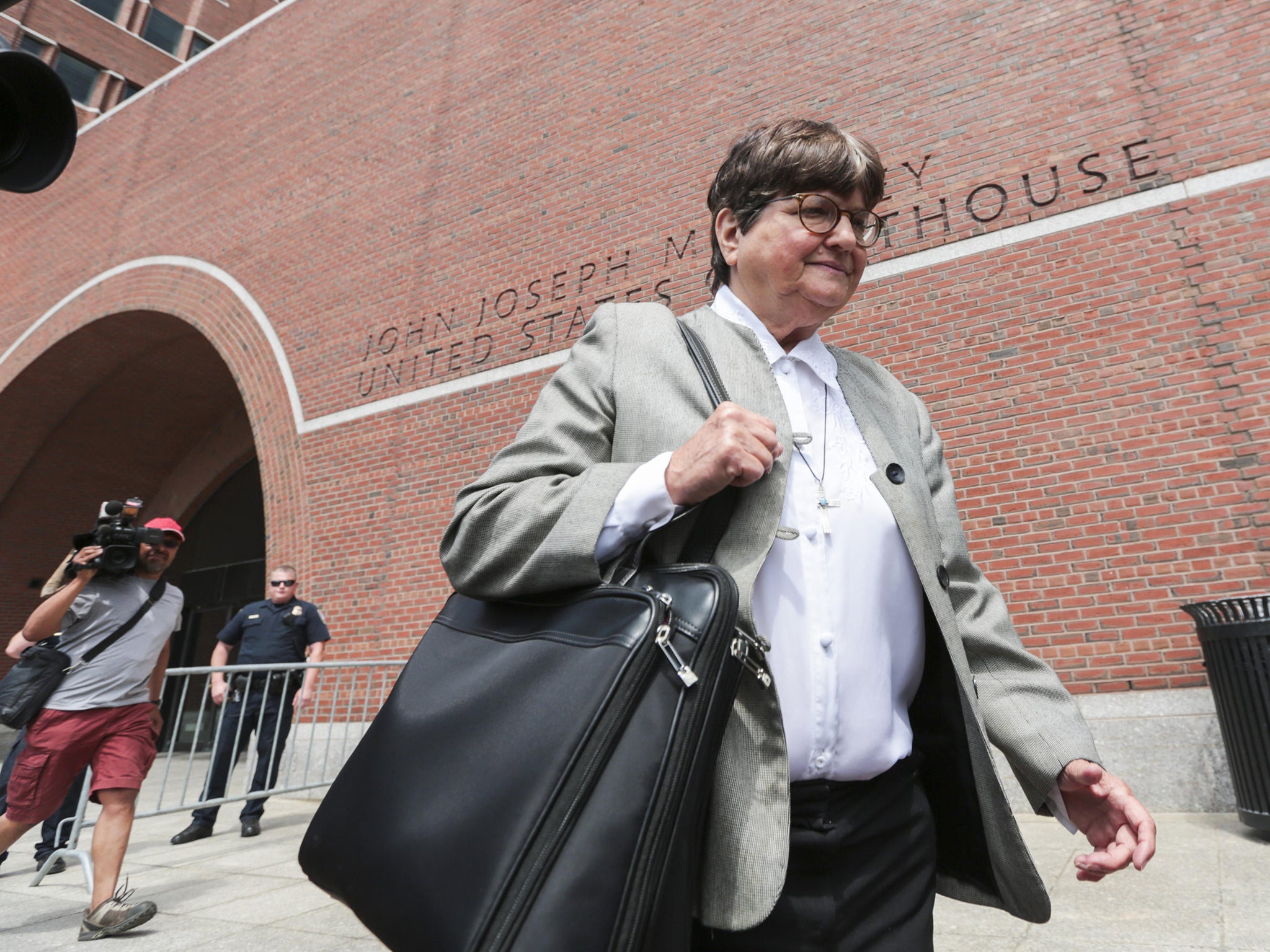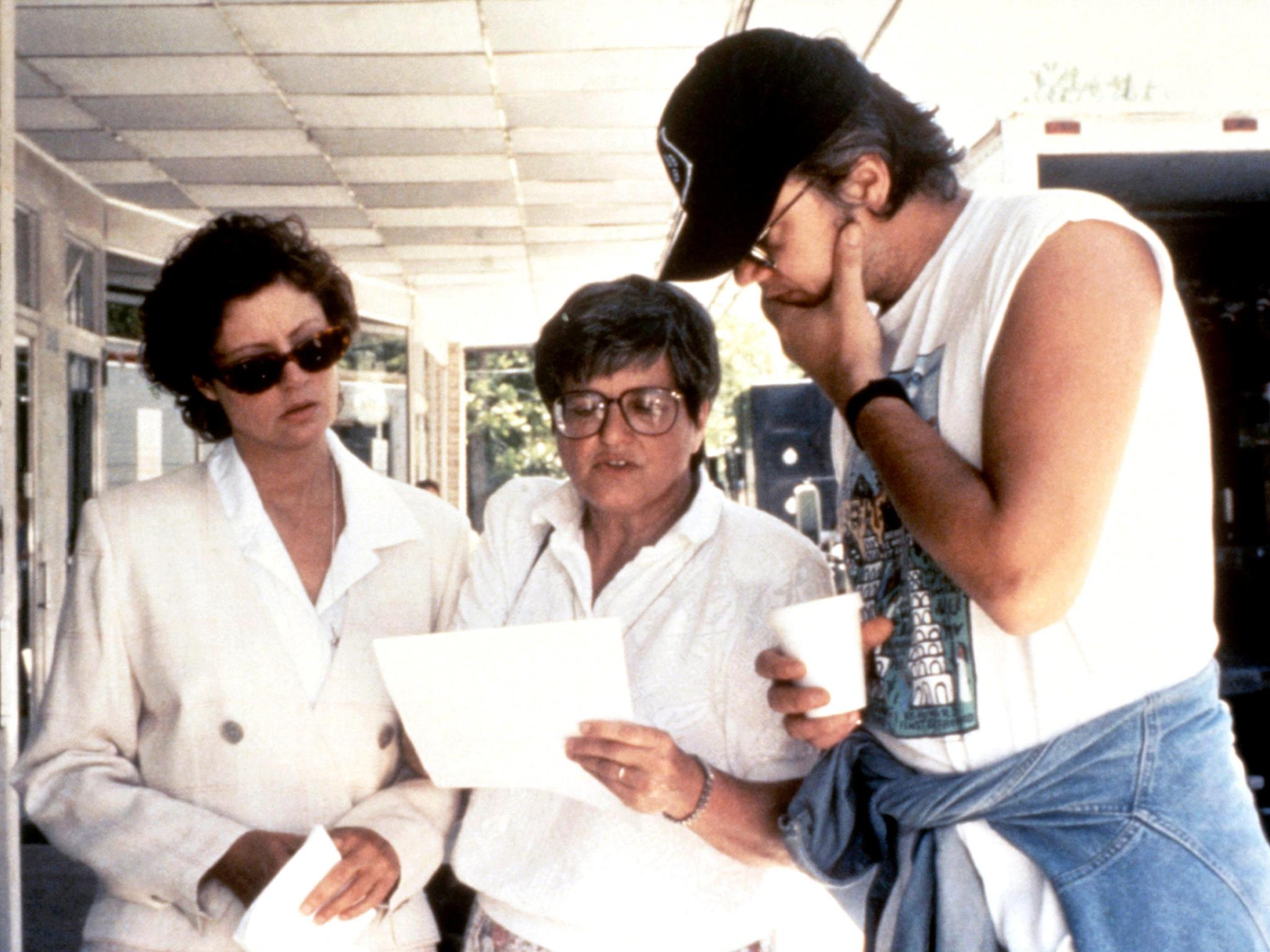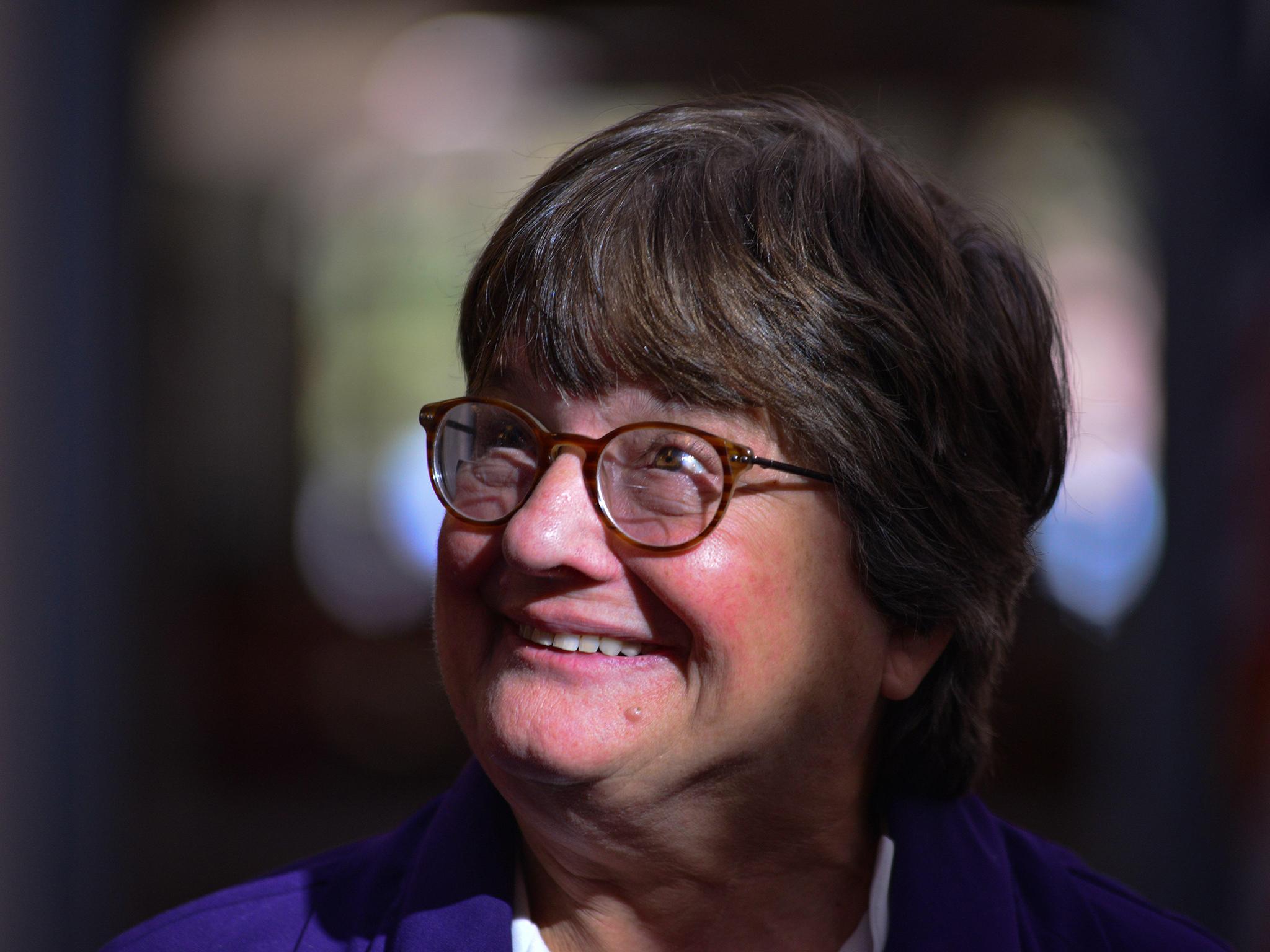Sister Helen Prejean: the most famous death-penalty abolitionist nun
Her 1993 book ‘Dead Man Walking’ – which was the basis for the film starring Susan Sarandon – details her experiences on death row

Your support helps us to tell the story
From reproductive rights to climate change to Big Tech, The Independent is on the ground when the story is developing. Whether it's investigating the financials of Elon Musk's pro-Trump PAC or producing our latest documentary, 'The A Word', which shines a light on the American women fighting for reproductive rights, we know how important it is to parse out the facts from the messaging.
At such a critical moment in US history, we need reporters on the ground. Your donation allows us to keep sending journalists to speak to both sides of the story.
The Independent is trusted by Americans across the entire political spectrum. And unlike many other quality news outlets, we choose not to lock Americans out of our reporting and analysis with paywalls. We believe quality journalism should be available to everyone, paid for by those who can afford it.
Your support makes all the difference.Thirty-five years ago, when Sister Helen Prejean was in the death house at the Louisiana State Penitentiary in Angola waiting to witness the execution by electrocution of Elmo Patrick Sonnier, the guard in charge asked her: “What’s a nun doing in a place like this?”
Dead Man Walking, her harrowing 1993 book about her experiences on death row, was one answer. In it, she writes of how she became a pen pal and spiritual adviser to Sonnier, who had been convicted, with his brother, of killing a teenage couple parked on a lover’s lane after raping the girl.
Prejean describes her horror at the barbaric crime and at its barbaric consequences, her stumbles with the victims’ families and her education into the injustices of the death penalty and death-penalty convictions. Her conversion to activism would in time make her one of the country’s best-known death-penalty abolitionists, and maybe its most famous nun.
The book was a New York Times bestseller, and then a movie, an opera (with a libretto by Terrence McNally) and an educational programme. The 1995 film, directed by Tim Robbins, starred Susan Sarandon as Prejean and Sean Penn as the death row inmate. Sarandon won an Oscar, wearing a coppery Dolce & Gabbana gown to the ceremony.
Prejean, who like many nuns had shed the habit in the late 1960s, wore a black top and a long flowered skirt she borrowed from a friend. “What would the nun wear?” was big news at the time, she recalls.
Today she is in a white polo shirt printed with sprigs of flowers, khaki-green denim pants and wedge sandals, ready to discuss her new book, River of Fire: My Spiritual Journey, published last Tuesday, a memoir of her life up until the moment she began to correspond with Sonnier.
In it, Prejean, who was raised in Baton Rouge and is of French Cajun descent, tells how a precocious Catholic girl turned nun shed her cocoon of privilege long after the social revolutions of the 1960s and the attendant reformations and renovations of the Second Vatican Council transformed many sisters into social justice activists.
“Don’t hold your breath,” she writes. “It’s going to take a while.”
But being a nun has always been a radical act. What’s more counterculture, she says, than joining a convent?
* * *
With short, bushy brown hair, big round glasses and a luxurious Louisiana way with vowels, she looks about 65, though she turned 80 in April.
She lives in a modest two-bedroom apartment, a few blocks from the fairgrounds in New Orleans, running her organisation, the Ministry to Abolish the Death Penalty, from the apartment next door.

The staff of five includes Sister Margaret Maggio, an old friend who is also in Prejean’s order, the Sisters of St Joseph, and Rose Vines, an Australian writer, activist and atheist. There are debates on cosmology and quantum physics over scotch (Sister Helen) and gin and tonics (Vines).
A framed print of Fra Angelica’s Annunciation hangs over Prejean’s computer monitor, taped to which is a photo of Dzhokhar Anzorovich Tsarnaev, the convicted bomber of the Boston Marathon, printed with the words “Pray for Dzhokhar”.
In 2015, after meeting with him five times at his lawyers’ request, Prejean testified on his behalf. The prosecution had fought hard to keep her off the stand, and attacked her testimony as being biased. “I presented him as human being,” she says. Nonetheless, the jury returned a death sentence.
In the bathroom, there is a quiz deck of landmark American Civil Liberties Union cases.
“Here’s the spark at the heart of all this,” she says. “The big annunciation” – she nods at her Fra Angelica print – “was writing a man on death row and witnessing his execution. When I walked out of that execution chamber, all this was new to me. I didn’t know anything about the criminal justice system. I love to quote what Tim Robbins said: ‘The nun was in over her head.’ Back then I didn’t know anything.”
I had to break out of two cocoons. One was the spiritual one that by praying you helped the world be a better place. And the other was white privilege because I was taken care of in every way
Prejean grew up in an affectionate Catholic family. Her father was a lawyer; her mother, a nurse. They loved language, drawing on both Roget’s Thesaurus and Groucho Marx – and the Virgin Mary. On family trips, the family of five said three rosaries a day, as Prejean writes, “surefire Catholic Prozac for three squabbling kids in the back seat”.
In eighth grade, she declared she would grow up either to be pope or president. She was curious about romantic love, but had ambitions outside of marriage and children. She was 18 when she joined the Sisters of St Joseph’s, an order begun in France in 1650 with a particular mission for the education of girls.
She was a scrappy, mouthy novitiate, often in trouble. Bounding out of the family station wagon on the day she joined the convent, she announced: “I’m here! I’m here to become a bride of Christ!’”
And she was wildly competitive, once practising the down-turned gaze meant to indicate modesty so zealously that she knocked down another nun.
Convent life wasn’t all rosaries and penances. When she and 13 other nuns in her community vacationed on an island off the Gulf Coast, they surfed in inner tubes and scarfed boiled crabs and cold beer. They listened to West Side Story and dissolved in tears.
On the first day of that vacation, an ethical dilemma presented itself. Before a trip to the beach, should they take off their habits in their camp, or cross the public highway in full nun regalia, and divest in the sand? It took half an hour of discussion before someone pointed out that the image of 14 nuns undressing on a beach and leaving their habits in a big black heap would perhaps be too unsettling.
Prejean read JD Salinger and Thomas Merton but was oblivious to the civil rights movement swelling around her, though she did learn to play “Blowin’ in the Wind” on her guitar.
At a religious education programme in Ontario, she met a young priest she calls William in the book, and they fell in love. Nuns and priests were experimenting with a relationship model called “the third way”, which was sort of like dating except the couples stayed celibate and true to their orders.
“If this sounds confusing and tricky in the extreme,” she writes, “that’s because that’s exactly what it is.” William was not only smitten with Prejean, he was also jealous and controlling, as well as being an alcoholic. It took seven years for her to end the relationship.
Then came a nascent feminist awakening, as she examined the meaning of celibacy beyond biology. Attending to William’s emotional needs, she writes, had consumed more and more of her time and focus, competing with “the single-heartedness” that is the essence of her vocation.
“Virginity is completely identified with sex,” she says, “what a person has not experienced. It’s that closed-off, puritanical kind of thing.” But Prejean’s practice of celibacy taught her that the Virgin archetype was something more radical. “It is the single-heartedness that is the integrity in one’s being,” she says, and then quotes Jean Shinoda Bolen, the Jungian author: “She does what she does, because what she does is true.”
It is a state available to everyone, she writes, even politicians. “Although in the United States, the brokering of money and power in politics sets the ‘purity bar’ pretty high.”
In the United States, the brokering of money and power in politics sets the ‘purity bar’ pretty high
Prejean’s awareness of social justice came even later, when she attended a talk by an activist nun who noted that Jesus’s message about the poor is that they be poor no longer. That their fate was not God’s will, and that just praying for people was not enough. Social justice, the nun says, meant being involved in political processes, because doing nothing was tacit support for the status quo.
What stung the most, she says, “was the realisation of how passive I had been”. A year later, she moved into Hope House, a Catholic service ministry in a New Orleans housing project. She was 42 years old. And a year after that, she would begin writing to a death row inmate.
“I had to break out of two cocoons,” she says. “One was the spiritual one that by praying you helped the world be a better place. And the other was white privilege because I was taken care of in every way. Nuns were held in great regard. We could ride the buses free. If we went to a restaurant, someone would pay the bill. I didn’t know any poor people. I didn’t know that right down the street from the convent where I was living, in the New Orleans suburbs by the lake, were 10 major housing projects. You grow up in these envelopes. My good mama and daddy would say, ‘Now honey, it’s better for the races not to mix.’ I didn’t know booscat!”
Her family was always supportive, though often her work and her eventual celebrity made for complications. There was the time her brother, Louis Prejean Jr, befriended Antonin Scalia, the late conservative Supreme Court Justice, at a wedding, and began to take him duck hunting. When the movie Dead Man Walking was about to come out, Louis Prejean proudly told the justice that his sister was going to be played by Sarandon.
As Prejean remembers, “Scalia says to him, ‘Just what we need. Another liberal book being made into a liberal movie.’ And Louie says, ‘Sis, I don’t think he’s too excited about your movie so I’m not going to bring it up anymore.’”
Scalia was an ardent supporter of the death penalty, a position that still confounds Prejean. “Human beings’ ability to compartmentalise is truly an amazing thing,” she says. “The way Scalia said, ‘As a justice, I must leave my Catholic faith at the door and follow the constitution,’ as if the moral imperative to be compassionate and forgive doesn’t give you a perspective when you look at equal justice under the law.”
Human beings’ ability to compartmentalise is truly an amazing thing
“Thomas Merton,” she adds, “said the end of the world will be legal.”
* * *
Prejean has witnessed six executions since she watched Sonnier die in 1984. The second to last death was Dobie Gillis Williams, an African-American man with an IQ of 65, charged in the horrific murder of a Louisiana woman. “With an all-white jury,” she says, “he didn’t have a chance.”
That was in 1999. Since then, she has been visiting Manuel Ortiz, who is also on death row in Angola, convicted of the murder-for-hire of his ex-wife for her insurance. Prejean and others believe he is innocent. The drive from New Orleans to Angola is two and a half hours, and Prejean has done it so often, she says, “my body knows the way”.

Sarandon has also made the trip more than once, most recently to visit Ortiz with Prejean in February. Theirs has been a long friendship and collaboration. At one point, the nun had her own bedroom in Sarandon’s New York apartment.
“She’s been a great mentor and a great friend,” Sarandon says. “Somebody who always makes me laugh. One of the mistakes people make is thinking that everyone who does this kind of work is really a bore. A Debbie Downer. But Helen is really fun. She is always on a mission to learn. She keeps her heart and her mind open.”
It took seven years to write River of Fire. Gloria Loomis, Prejean’s longtime literary agent, had been pressing the nun to tell her story for some time, but she was always on the road.
She travels three-quarters of the year, and has spoken in all 50 states. She makes a silent retreat every year at the Trappist Monastery in Kentucky, Thomas Merton’s community, and she has been awarded 65 or so (no one is quite sure) honorary degrees, the most recent being a doctorate in divinity from Yale this spring.
It’s a far different life than one lived in a cloister, though Prejean says she considered that path for one weekend in high school. (Sarandon says: “You can imagine how crazy Helen would have been in a cloister.”)
“There’s this thing of how you discern God’s will in your life,” Prejean says. “Or how your boat catches a wave and you begin to ride the current. There’s different ways of talking about it.”
© New York Times
Join our commenting forum
Join thought-provoking conversations, follow other Independent readers and see their replies
Comments